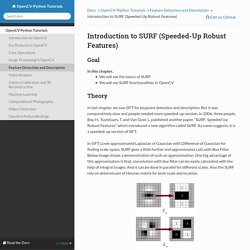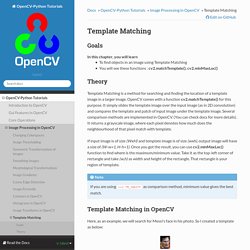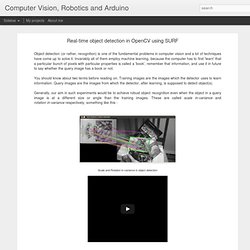

Cyrille Rossant's blog - Create a standalone Windows installer for your Python application. I am developing a scientific application in Python with a graphical user interface in Qt.

Some end-users use OS X or Linux, but most of them are Windows users who are not familiar with Python or with a command-line interface. So You Want to Accept Credit Cards Online? Until recently, accepting credit cards on a website was expensive and complicated.

But that was before Stripe: a radically different and insanely awesome credit card processing company. Today, I'll show you how to start accepting cards in 30 minutes or less - without spending a dime. Republished Tutorial Every few weeks, we revisit some of our reader's favorite posts from throughout the history of the site. This tutorial was first published in June, 2012. Introduction to SURF (Speeded-Up Robust Features) — OpenCV-Python Tutorials 1 documentation. Theory¶ In last chapter, we saw SIFT for keypoint detection and description.

But it was comparatively slow and people needed more speeded-up version. In 2006, three people, Bay, H., Tuytelaars, T. and Van Gool, L, published another paper, “SURF: Speeded Up Robust Features” which introduced a new algorithm called SURF. As name suggests, it is a speeded-up version of SIFT. In SIFT, Lowe approximated Laplacian of Gaussian with Difference of Gaussian for finding scale-space. For orientation assignment, SURF uses wavelet responses in horizontal and vertical direction for a neighbourhood of size 6s. .
For feature description, SURF uses Wavelet responses in horizontal and vertical direction (again, use of integral images makes things easier). . For more distinctiveness, SURF feature descriptor has an extended 128 dimension version. And. Screen - How do I get Monitor resolution in Python? Sudoku Solver - Part 1. Greg Czerniak's Website - Kalman Filters for Undergrads 1. OpenCV-Python Tutorials — OpenCV-Python Tutorials 1 documentation. Main. 15 essential mobile game development tools. From all-in-one indie dev packages to plug-ins for improving player engagement, we bring you a guide to the best mobile game development tools available [This feature was published in the October 2013 edition of Develop magazine, which is available through your browser and on iPad] You’ve got to be in it to win it.

And to win it in today’s market, you’ve got to be on mobile. Global successes such as Candy Crush Saga, Clash of Clans and Puzzle & Dragons have helped push gaming even further into the mainstream. To help you reach these lofty heights, Develop has assembled this all-star guide to app and mobile game development tools. MARMALADEMarmalade SDK is billed as the fastest way to build cross-platform C++ games. In 2013, the firm launched two significant supplements to its flagship SDK, which it feels has helped to serve the needs of Marmalade users better.
And a little code goes a long way with Marmalade Quick, an acceleration tool with a fast, flexible and open environment. Top Game Development Tools: Pros and Cons - Developer Economics. According to our survey, a surprisingly high 29% of games developers are primarily building their apps without a third party engine*.

They have either written their own engines, or are building everything from scratch. Large games studios very often build their own engines and tools, or customise open source solutions to suit their own internal processes and workflow. However, two of the most popular developer segments going for this option are Hobbyists and Explorers. What are the best 2D Game Engines? - Slant. Template Matching — OpenCV-Python Tutorials 1 documentation. Goals¶ In this chapter, you will learn To find objects in an image using Template MatchingYou will see these functions : cv2.matchTemplate(), cv2.minMaxLoc() Theory¶ Template Matching is a method for searching and finding the location of a template image in a larger image.

OpenCV comes with a function cv2.matchTemplate() for this purpose. If input image is of size (WxH) and template image is of size (wxh), output image will have a size of (W-w+1, H-h+1). Note If you are using cv2.TM_SQDIFF as comparison method, minimum value gives the best match. Template Matching in OpenCV¶ Here, as an example, we will search for Messi’s face in his photo. We will try all the comparison methods so that we can see how their results look like: See the results below: How to Make an Augmented Reality Game with Open CV. If you're new here, you may want to subscribe to my RSS feed or follow me on Twitter.

Thanks for visiting! Make the world your virtual target range in this Augmented Reality tutorial Looking to make your neighbor’s car explode by an errant cruise missile without the the hassle of court dates? With a mobile boom, learning games are a $1.5B market headed toward $2.3B by 2017 (exclusive) Educational games, also known as “serious games,” are going through a renaissance in part because of the acceptance of learning apps on mobile devices.

That’s the finding of a new research report by Ambient Insight. The forecast predicts the Serious Games market, which Ambient calls game-based learning, will grow from $1.5 billion in 2012 to $2.3 billion in 2017. The larger simulation-based learning market, which includes corporate training games, is expected to grow even more from $2.3 billion in 2012 to $6.6 billion in 2017.
Real-time object detection in OpenCV using SURF. Object detection (or rather, recognition) is one of the fundamental problems in computer vision and a lot of techniques have come up to solve it.

Invariably all of them employ machine learning, because the computer has to first 'learn' that a particular bunch of pixels with particular properties is called a 'book', remember that information, and use it in future to say whether the query image has a book or not. You should know about two terms before reading on. Training images are the images which the detector uses to learn information.
Query images are the images from which the detector, after learning, is supposed to detect object(s).